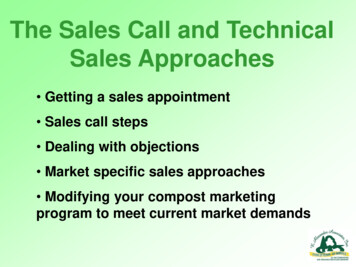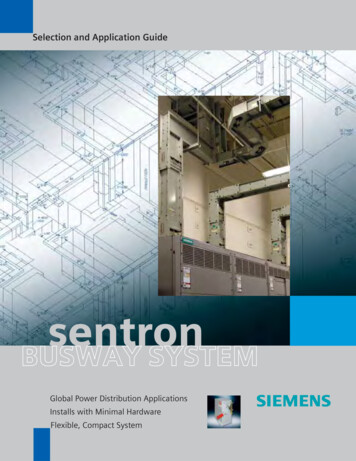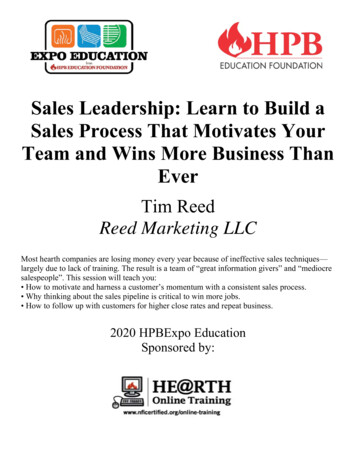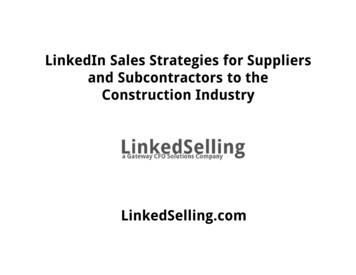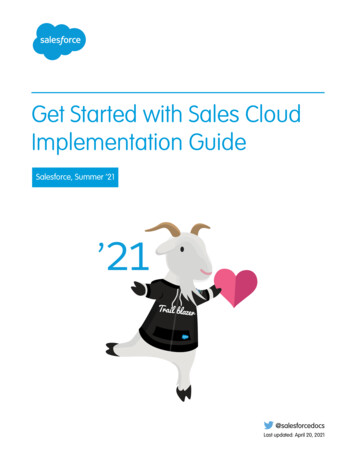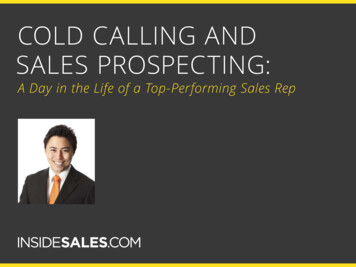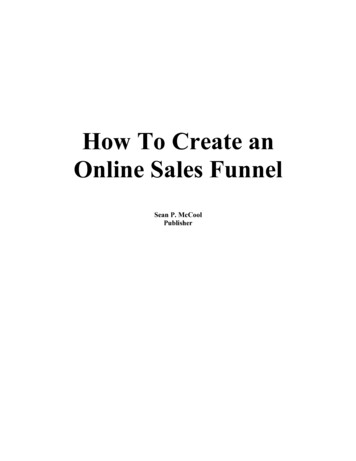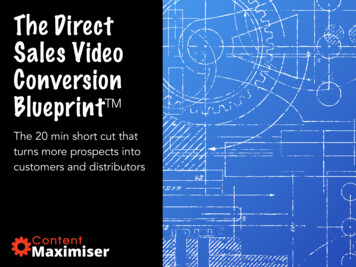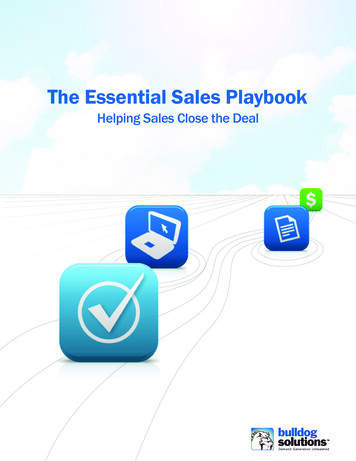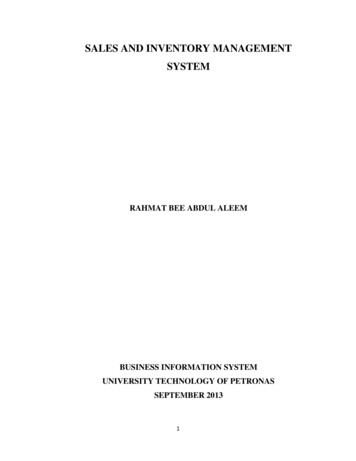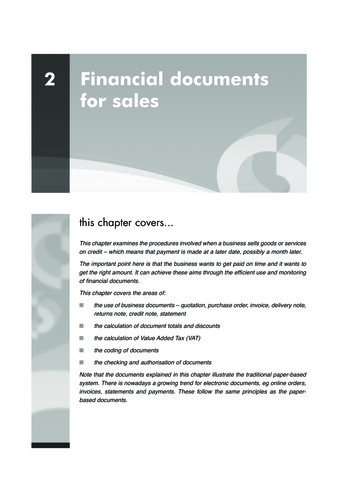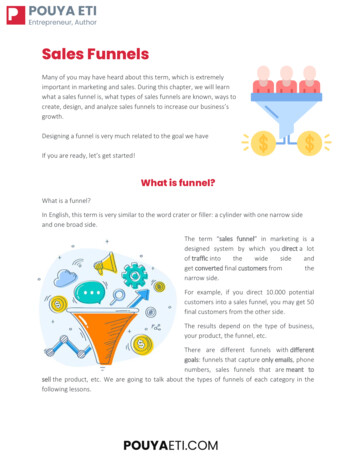
Transcription
Sales FunnelsMany of you may have heard about this term, which is extremelyimportant in marketing and sales. During this chapter, we will learnwhat a sales funnel is, what types of sales funnels are known, ways tocreate, design, and analyze sales funnels to increase our business’sgrowth.Designing a funnel is very much related to the goal we haveIf you are ready, let’s get started!What is funnel?What is a funnel?In English, this term is very similar to the word crater or filler: a cylinder with one narrow sideand one broad side.The term “sales funnel” in marketing is adesigned system by which you direct a lotof traffic intothewidesideandget converted final customers fromthenarrow side.For example, if you direct 10.000 potentialcustomers into a sales funnel, you may get 50final customers from the other side.The results depend on the type of business,your product, the funnel, etc.There are different funnels with differentgoals: funnels that capture only emails, phonenumbers, sales funnels that are meant tosell the product, etc. We are going to talk about the types of funnels of each category in thefollowing lessons.
It is important to know that before designing a sales funnel, we need to specify our goal. What isthe primary goal of the funnel? Depending on the type or price of the product you need to usedifferent funnels.A funnel blueprint can be the following: you design a funnel for social media platforms throughads, where you aim to get your potential customers’ emails. Then you direct those emails intoanother funnel, from which you already getyour final customers who make a purchase ofyour product or service and bring revenue toyour business.So in one business process, you can usedifferent funnels, which will help get to yourfinal goal.Besides designing a sales funnel, we needto focus on its quality. The quality of a funnelcan be evaluated through its conversion rate.“Conversion rate” is the percentage ofthe initial number of potential customersdriven to the funnel and final customers whohad made a purchase. Usually, a goodconversion rate is between 5-10%.This is the main definition of sales funnels. In the next lesson, we will discuss the differentcategories of sales funnels; we will discuss ways to create efficient sales funnels to grow yourbusiness.Funnel TypesIn this part, we are going to take a lookat different categories of funnels.Each category that we discuss hasdifferent sub-categories, and along ourcourse, we will go deeper into exploringeach of them. Before studying eachcategory, we need to evoke notions ofcold, warm, and hot traffic.
“Traffic” is the people whom we direct into our funnels, expecting them to become actualcustomers.The traffic that we direct to our funnels can be cold, warm, and hot.Cold traffic – are the users who don’t know us, our company, neither ourproduct. They have no information about our business.Warm traffic – are the people who have some information aboutyou. They have heard about you, they know your business and know your product.Hot traffic – people who know you well haveclear information about your product andare very interested in buying it.Not let’s talk about types of funnels.Lead FunnelsThe specificity of this is a funnel capturing information – phone numbers, emails, and other typesof auxiliary information. As this funnel is not meant for sales, the conversion rate should behigher than sales funnels’.Inside the lead funnel, we have two sub-categories Squeeze page funnelApplication funnelWhenever we use lead funnels, we can expect to have a 20-50% conversion rate. When you drivecold traffic of 50K users into the lead funnel, by the end you get 20K emails or phone numbers.These are the people who saw your product, subscribed to your email list, and are in touch withyou. So you converted these people from cold traffic to warm traffic.Then you need to put these people to other funnels to convert them from warm to hot traffic. Todo this, you need to put them in sales and event funnels. Let’s talk about them.
The sales funnel This type aims to sell a product. We use this funnel to direct traffic from a source to make finalsales and get revenue. This category has three types of sub-categories.Tripwire funnelSales letter funnelPLF (Product launch funnel)Because we are making sales through this funnel, the conversion rate will be lower. 515% conversion rate for these types of funnels is a good result.We will have a separate lecture for each of the types of a sales funnel.Event funnels WebinarsAuto webinarsWhy do we need these three types of funnels? How and where can we use them? Keep up to getmore information about each one of them in the next lectures.Lead FunnelsSqueeze Page FunnelsThe squeeze page funnel is the first sub-category of lead funnels.Usually, squeeze page funnel is aimed to captureleads – emails, phone numbers, other contactinformation.We see this type of funnel numerous times daily inalmost any website we navigate. Usually, we see it inthe following structure: separate landing page, whichshows us the company/product/service name, shortdescriptional information, and a subscribe button.Another squeeze page funnel example is a pop-up onany website, with an offer and subscribe button.
A key factor in this type of funnel is the reward. You have to offercompetitive compensation/reward for people in return for providing you with their emailaddress.My personal example: on my website, I have a note “If you want to learn how to increase theengagement to your Instagramposts, write your email, and you willget a link to my video lesson forFREE.”I promise a reward to my users forproviding me the information I wantto get.A good reward option is a discount.This is an excellent compensation,especially if your users areinterested in your product orservice.Besides being advantageous and motivational for the potential clients, the reward must alsobe clearly mentioned in the description or title. The user must clearly see what will he/she get ifthey leave their email address.As I said earlier, the squeeze funnel consists of several important contributes.First, let’s talk about the title. In this part, you have to hook your potential clients. The titlemust be engaging;it must provokecuriosity and pushyour visitors toaction. Forexample, “7 waysto get ” “How toincrease your FBpost engagement for 20%”, “Key secrets of millionaires,” “10 habits all successful people have”,etc. They provoke interest, don’t they?The example of my IG squeeze funnel is best. Why? I know that the people, who subscribe to getthis lecture, are interested in Instagram. So if I have an Instagram marketing course, I can easilymake them warm instead of cold lead by directing them to purchase my webinar.
Button. Most people use “sign up” or“subscribe” buttons, but users usually do notact well on these notions unless they are100% sure of your product. Instead, it wouldbe best to write it more extraordinarily andinterestingly, for example, “Get your 20%discount coupon“. This is the part whereyou use your creativity to be more efficient.Instead of writing “sign up to get 50%” youcan write a title “Instead of a 15% discount,get your 50% discount from your first orderby subscribing to our newsletter. Now goahead and boldly click the button, “Claim itnow.” Do you see the difference? This is amore creative way to ask your website visitors to leave their emails for you.Another important moment you need to consider: we mentioned before that the lead we arecollecting with squeeze pagefunnels is not only the emailbut also the phone number ofyour users. Indeed, it dependson the type of your businessand its geography. Still, if youare operating locally, yourchances are higher if youdo SMS marketing than emailmarketingbecause peopletend to check their phonesmore frequently than theiremails.Once again, practice is the most effective way to get better in what you learn, so before heading tothe next lecture, take your time and navigate through different websites to check out forsuccessful and unsuccessful squeeze funnel examples.
Application FunnelIf you have ever purchased an expensive product or service, mostly over 500-1000 USD, you haveprobably gone through the application funnel.Basically, the client goes through a process of filling in aform with a lot of information about himself, which endswith “We will contact you soon” note.The advantage is that you obtain relevant, indepth information about your potential customers,so you can tailor an appropriate sales strategy asthey get closer to the end of the funnel.This is especially true to the products, the pricepoint of which grows higher. When you launch highend products, you need to adapt your strategy foreach client to make sales. Why? Because it is muchharder to get cold traffic to buy a product that costs 9,000than for a product that costs 15.But some products are simply more tailored to specific people than they are to others. That iswhy you use the application form to collect all the necessary information about your potentialclients, filter them to sort quality clients, and then make a call to convince them to purchase.Depending on your business, you can research more to find suitable application funnel types tounderstand which information is most convenient and applicable for your business.
The sales FunnelsTrip Wire FunnelThis funnel is meant to make sales of low-cost products around 10 .Let’s look at how it usually looks like.First of all, you need to have a landing page for your product, where you direct the traffic, which,by the way, should be warm. Usually, on one column, you write the product description andcontact information. On the other one, you direct the users’ steps towards the purchase page:the user writes his/her contact information, credit card details, meets shipping information, etc.The goal is to bring warm traffic to the landing page, pass it through the tripwire funnel with thehighest possible conversion rate.For example, if you bring traffic of 100 users, the conversion rate is 15%, which means that 15people will buy the product, and you will get 150 revenue. As you have only 1 type of productof 10 , your average cart value (ACV) is 10 – not more, not less. How can we increase that?One of the common ways to increase ACV isthe order bump, also known as OTO (onetime offer). It is an additional productavailable only for this time only for thisextra-low price that the buyer can add tohis/her cart by simply ticking a box.Another way to increase the ACV is called“upsells“. Whenever your client makes apurchase, instead of directing them to the“thank you” page, you direct them toanother product page with information andpricing, offering to buy another product for67 , for example. If two, three, or fourpeople from 15 clients agree to buy theupsells page offer, you will haveyour average cart value increased. You canhave one, two, or more upsell pages, but Iusually stick to two: I definitely don’t want to annoy my clients.
You have met the traditional upsell strategy in Mc. Donalds. When you order a burger for 4 ,they offer you a Cola for 3 , another cheese or barbecue sauce for 3 , ice-cream or dessert for5 , etc.So if you want to make more money out of your sales, you need to use these upsell and orderbump strategies. Usually, Amazon uses this strategy: you choose a product to buy, they offeradditional products that other users generally buy along with it as a package. It helps to increasethe ACV.Sales Letter FunnelThe next sub-category of sales funnels is called “Sales letter funnel”.In the tripwire funnel, we had a simple form and information about the product. That was all.The sales letter funnel usually works best for products that worth about 10-100 . Not in all cases,of course: it depends on your niche, on business, on type of product, as well, but mainly for thementioned cost products.Usually, it operates the following way: you got the landing page or website, there you havea descriptional or advertising video, you have more information about the product,some features and images of the product, a “claim your coupon” or another innovative button,some testimonials, customers review videos, etc. You can put advantages of your product anddisadvantages of other products on the market,including weight, measurements, shippingdetails and dates, and any additional usefulinformation. Every single information hereis helpful for users to make a purchasedecision.The rest is the same: you direct themto upsell, purchase and thank you page.Again, I remind you aboutthe importance of practice. If you want to besuccessful in this part, look at successful brands‘and their product pages (I, personally, mainlyuse Amazon product pages as a guideline). Takeyour time to investigate the way they use thesales letter funnel. Learn the type ofinformation they put on their products’ description pages; explore and research successfulbusinesses and their strategies, and you will get a lot of useful skills for your own business.
Let’s move on to the next funnel!Product Launch FunnelThis is the last sub-category of the sales funnels calledthe product launch funnel (PLF). Naturally, you usethis funnel right before the launch of your product,and, usually, you perform the PLF through emailmarketing.So you have the sorted and filtered email list of yourpotential customer. What next? Every day you sendthem an email with new information about theproduct.The structure is approximately the following:Day 1 – video about your productDay 2 – Video # 2 about your product (you can tell the story of the creation of your product,add emotional notes, speak about the idea and process of its design and realization, etc.)Day 3 – product launch day – with another video of the product, direct your traffic towardsthe purchase page (credit card details, shipping information, check-out). - Upsell 1 - Upsell 2 - So mainly, you send your potentialcustomers daily videos t
The sales funnel This type aims to sell a product. We use this funnel to direct traffic from a source to make final sales and get revenue. This category has three types of sub-categories. Tripwire funnel Sales letter funnel PLF (Product launch funnel) Because we are making sales through this funnel, the conversion rate will be lower. 5-
